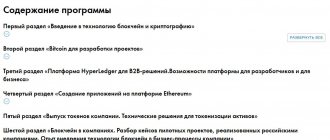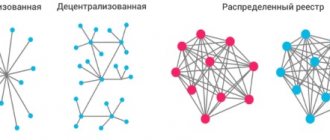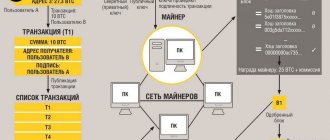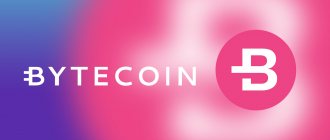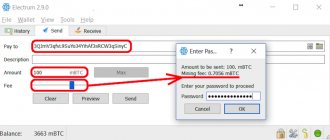Good afternoon, dear visitors and regular readers of the blog! Today we would like to tell you about one of the most popular and popular wallets for storing cryptocurrencies - Blockchain (official website). You will learn about its advantages over other storages and its disadvantages. We will describe in detail the process of registration, replenishment, and ways to send coins to other people.
Currently, Blockchain has only one worthy competitor - Coinbase, so let's figure out why and how they differ.
The Blockchain.info platform was launched in August 2011 in Luxembourg and immediately attracted attention because it was not an ordinary cryptocurrency wallet, but also provided detailed information about all transactions, which other services could not boast of. Users can track online the status of sending and receiving coins, the total number of transactions carried out, the number of confirmations of any of them and the amount of commission fees. Now Blockchain is constantly developing, more than 23 million wallets have already been registered, the number of transactions has exceeded 100 million, and the ability to store not only Bitcoin, but also Ether and Bitcoin Cash has been implemented. These figures speak for themselves.
The downside of this service is that it is still an online wallet, which means all available cryptocurrency is stored on the company’s servers. If you decide to opt for Blockchain, then we recommend using it to store a small number of coins, exclusively for daily transactions. For long-term storage, it is still better to install a full-fledged wallet on your PC or use hardware storage.
Main characteristics
- Start of work : August 2011
- Category : Cryptocurrency wallet
- Administration : Peter Smith and Nicholas Carey
- Security : high degree of security, three levels of account protection (see more details in the “Security” section
- API : all documentation is here
- Languages : the platform has been translated into more than 20 languages, including Russian
- Personal account : the interface is very convenient and simple, all information is divided into the appropriate sections, SSL protection, GreenBar
- Support : the site has a FAQ section, in addition, you can send a letter to technical support
- Cryptocurrencies : Bitcoin, Bitcoin Cash, Ethereum
- Fees : the size of fees depends on the load on the blockchain network, it is possible to change its size manually
- Affiliate program : none
- Mobile service : applications for IOS and Android have been developed
How to withdraw money from the blockchain using WebMoney
Don't be discouraged if none of the methods discussed are suitable for you. Another option is to withdraw money to WebMoney. In the wake of the increased popularity of cryptocurrencies, the electronic payment system WebMoney has developed a special service for replenishing and withdrawing bitcoin, including from a bitcoin wallet.
How to buy and sell cryptocurrency via WebMoney (WMX)
To use it, you need to get a Bitcoin address on the WebMoney network. After that, enter the address in your wallet when transferring money. Bitcoin will be transferred to WebMoney, where you can exchange it for EUR, RUB, UAH. After this, you can easily cash out or withdraw bitcoin to your card.
You will not be able to receive money directly for other payment systems and credit cards, only with the help of crypto exchanges, exchangers, and Internet intermediaries.
Reviews:
@Rob
The Bitcoin wallet on WebMoney is conveniently implemented, I didn’t see any disadvantages. The commission is low, anonymity is maintained, since all transfers are made through standard Bitcoin addresses, and the funds are stored on the WMX wallet.
@Dino
The downside is the volatility of the cue ball. Replenishing a wallet on WMX is not at all instant; you will have to wait a day or even more until the transfer is accepted from the blockchain wallet! And during this time the course may change significantly. For me, this criterion is important, so it’s not always convenient.
@Li
Difficult verification, so-so commission.
Pros and cons of the wallet
Click to enlarge
✅ The most popular platform for storing, receiving and sending electronic currencies, operating worldwide.
✅ Lack of identity verification.
✅ Ability to track a transaction and see detailed information about it.
✅ Ideal for regular use of small amounts of coins.
✅ It is possible to make a backup copy of funds in order to protect them from unauthorized access.
✅ Inside the wallet, you can carry out operations to exchange one digital currency for another, without using third-party services.
✅ Dynamic commissions depending on network congestion. Ability to set its size manually.
✅ High level of wallet security.
✅ Convenient and functional applications for smartphones and tablets.
❌ Private keys are not issued to users. This means there is a risk of losing your coins when the platform is closed.
❌ You can find negative reviews online about the quality of the technical support service.
❌ Limited number of supported cryptocurrencies. In this, Blockchain is inferior to the Coinpayments wallet.
What are transactions on the BTC network
Blockchain blocks are elements of a cryptocurrency network that store information about events that have occurred (in the case of cryptocurrency, about completed transactions). The information in the new block refers to the information in the previous node, so the elements of the chain are interconnected with each other and protected from outside interference.
READ Blockchain system - what is it in simple words
Transactions in the blockchain ensure the creation of blocks. With the growing demand for digital money, the number of transfers has increased, and the number of transactions that fit into a chain element varies within a small range. When mining cryptocurrency, priority transactions with larger commissions and volume are included in the blocks. Small operations form a queue and bide their time. Upon creation of a new blockchain element, miners receive a reward of 12.5 coins (as of December 1, 2020).
The transfer records the following information: sender's wallet number, amount of the amount, recipient's wallet address. You can check the information at any time. You need to go to a special service and enter the transaction number. The system provides information about the time and amount of the transfer, the amount of the commission and other data.
The blockchain chain is distinguished by the absence of a single control center. The transaction history is simultaneously located on hundreds of thousands of user PCs and is regularly updated. Money is credited to the wallet after the transaction is validated (checked) by other users (miners). The speed of transferring funds depends on many parameters and reaches 10 minutes or more.
To conduct a transaction on the blockchain network, two keys are required:
- Private - confirms the ownership of the sent coins to the owner, ensures the transfer of money.
- Public—shows the path for depositing coins. This is the address of the wallet that accepts coins.
The transaction has the following algorithm:
- A sender with a private key sends a certain number of coins to another user.
- Information about the operation goes to the blockchain.
- The created block is added to the general chain with information about the transfer.
- Network participants check validity.
- The transaction is confirmed after 2–6 blocks (for a blockchain chain).
- The money is credited to the recipient's wallet.
If you provide the information correctly, the transaction takes a minimum of time (from 20 minutes), but this does not always happen.
READ Blockchain technology - the essence and prospects of Blockchain
Process of working with a wallet
Now let's take a step-by-step look at the process of registering a new wallet, replenishing it and sending electronic currencies. So, go to the official website and click “GET A FREE WALLET” in the upper right corner.
A new window opens in the browser where we must fill in all the fields:
- Specify your email address;
- Unique complex password;
- Repeat password.
To create a complex password, use specialized storage programs: KeePass or LastPass.
As you can see, you don’t need to enter any personal information; the system will assign a login, that is, the user ID by which you will log in, automatically. Now we mark the point that we are familiar with the terms of provision. That's it, now your wallet has been created and you can familiarize yourself with its interface, as well as make the necessary security settings. In the meantime, a letter will be sent to your email address in which you need to confirm your registration. It will also contain your ID number for future logins.
In front of you is a desktop. On the left are tabs that provide information about the number of coins of each cryptocurrency in your Blockchain wallet and information about transactions. Let's look at an example:
If you click on the “Bitcoin” tab, you will see the history of sending/receiving BTC currency in the main area.
To send coins, click “Send” at the top of the desktop and fill out all the fields. You can select the type of commission fees “Regular” or “Priority” or set its size manually by clicking “Customize Fee”.
To receive coins, click “Get” at the top of the desktop. In the window that opens you will see your wallet number. It is dynamic and updated once a day, but the old numbers also belong to you and you can receive cryptocurrency from them. So don't be alarmed when you see a new address in this field. Give it to the coin sender or fill out the remaining fields: indicate the amount to be received, a comment and click “Next”. You will receive a link by clicking on which the sender will be able to make a transfer.
Key Features of Blockchain Browsers
The block explorer is capable of providing almost any information recorded in the blockchain. This could be the blocks themselves, transaction data, smart contracts, and the like. On the main page of any browser there is always a feed of blockchain blocks; the most recent ones will be displayed at the top, and to view older blocks, you need to expand the feed. Each line of the tape is a separate block and in itself already provides quite a lot of information about it, for example:
- Block Height. This is the height of the block or, in other words, its serial number in the blockchain chain.
- Block Age. Age or the time that has passed since the block was added to the blockchain.
- Transactions. The number of transactions included in this block.
- Relayed By / Mined By. The name of the miner or the one who added this block to the chain.
Bitcoin observers add information about a new block almost as soon as it is confirmed. Sometimes this happens almost in real time, sometimes with a slight delay, however, the information provided is always fresh and relevant.
However, the information discussed in the previous paragraph is only the tip of the iceberg. The block number works as a link, following which we get to a page where everything that can be related to the issue of its functioning is considered. In fact, we are provided with all the detailed information, including the previous one, but now it is also supplemented with information such as:
- Hash. A unique identifier built on confirmation algorithms and including data on the hash of the previous block.
- Transaction Fee. Or in other words, transaction fees. Represents the total value of all commissions in the block.
- Transaction. Data about all transactions included in a specific block of the blockchain.
Some Bitcoin browsers also have a separate tab for transaction data on the main page. This is undoubtedly even more convenient, however, the presented functionality is already sufficient for completely comfortable work and analytics. The main advantage of any browser is the ability to analyze a single transaction in detail and find out as much detail as possible about it. If a browser provides such an opportunity, then in any case it can be safely called a worthy representative of these resources.
Safety
Click to enlarge.
Security Center offers users three stages of account settings.
Stage one:
- Email verification;
- Secret backup phrase to restore access to your funds if you have forgotten your password or the service is unavailable;
- Generate a hint for your password.
Stage two:
- Linking your mobile phone number to your account to receive a one-time code each time you log into your wallet;
- Two-factor authentication.
Stage three:
- Blocking IP addresses that are part of the Tor anonymous network due to the fact that this network is often used by hackers for hacking.
Wallet settings
As you remember earlier, we wrote that after registration you will receive a letter indicating your unique user ID. Write it down right away. If for some reason this was not possible and the letter was deleted, go to the “Settings” - “General” tab in your wallet. Your ID will be listed there. Here you can synchronize your wallet with the mobile application to constantly display up-to-date data. Just select this option and follow the system's recommendations. In the General settings section, you can also import coins from your MyEtherWallet storage into the Blockchain. All other settings are quite banal: you can select the preferred currency in which your balance will be displayed, wallet language, methods of receiving notifications, etc.
How to check a transaction
If a user sent coins to another person, and after an hour the tokens have not reached the recipient, it is better to check the transaction. There are special services that allow you to track the transfer path and obtain the necessary information. The most popular services:
- Blockchain.com/ru/explorer is a platform with easy navigation and attractive design. To obtain information, you must enter a wallet address, transaction number, hash, or block.
After specifying the transaction number, the system displays the time of its receipt, size, block reward and transfer volume.
- Btc.com is an equally popular service that allows you to track a transaction in the blockchain chain. To obtain information, the transfer number, block or address is indicated in the upper right window.
After entering the information, the service issues the block size, confirmation, execution time, transaction size, paid commission and other information.
- Blockexplorer.com is a convenient blockchain transaction explorer with good functionality. The window for entering information about the transfer is located at the top left.
The result is displayed in the form of a small table with a limited amount of data. Users have access to the size, transfer time and a number of other information.
- Etherscan.io is a platform for checking transactions on the Ethereum network. The site is distinguished by great functionality, convenient display of necessary information, and free use.
After entering the information, the system displays the block size, sender and recipient, limit and price of Gas, and other data.
These platforms are sufficient to obtain complete information about transactions in the blockchain of Bitcoin, Ethereum and a number of other cryptocurrencies.
Confirmed and unconfirmed transactions
To understand how services work, it is important to know the difference between two types of transactions in the blockchain network:
- Confirmed - transfers included in the block after validation by miners.
- Unconfirmed - transactions that are not included in the new element of the chain (for example, due to a large load, low commission or incorrectness).
The number of confirmations ranges from one to six (depending on the number of Bitcoins being sent). The time of the transaction depends on this factor. For example, if a transaction requires one confirmation, within ten minutes the money will be in the recipient’s wallet. For six blocks, the operation time takes an hour or more.
READ Blockchain info – a technological breakthrough with huge prospects
An unconfirmed transaction on the blockchain is a transaction in limbo. The owner sent money to the recipient, but the funds did not arrive due to the lack of the required number of confirmations. A common reason is low commission due to increased network load. In such a situation, there are two ways - wait for the transaction to take place or speed up the operation.
Blog opinion and reviews
The Blockchain wallet is now the most popular among newcomers to the cryptocurrency space due to its easy-to-understand interface, ease of use, the presence of at least two major digital currencies - Bitcoin and Ethereum, and the ability to fully track every transaction made. But for more advanced users, the disadvantages of Blockchain are more critical, who would want to store a large number of coins knowing that they will be lost when the service is closed. Of course, no one is talking about such a terrible prospect and there are no prerequisites for this, but to store large volumes, we still recommend using the most stable wallets in this regard, which do not store cryptocurrency on their servers. We hope we were able to explain to you all the nuances of working with Blockchain and our review was useful to you. If you are interested in the topic of cryptographic currencies and their storage, we recommend reading a number of our articles.
How to conduct anonymous transactions on the Bitcoin network
Many users are not satisfied with the level of anonymity provided by the Bitcoin cryptocurrency network. In such a situation, additional methods can be used to provide better privacy. Popular options:
- Blender.io is a service that provides complete anonymity of Bitcoin transactions on the blockchain network. Advantages of the site: low commission (from 0.5 to 3%), lack of JS, mixing using updated algorithms, convenient and accessible design. A network participant has the right to independently set the amount and time of the transaction. Mixing code is available to users to ensure that old and new operations are not mixed. To anonymize a transfer, you need to enter the address of the recipient of the coins, the mixing delay, the commission and the code. Then you can start mixing.
- Вarkwallet.is is an address where a special wallet is available, ensuring the confidentiality of transactions on the blockchain network. The developers are A. Taaki and K. Wilson. The special feature is improved protection of storage owner identifiers. During the operation, the system combines information from simultaneous translations of different participants. It is almost impossible to understand which translation applies to whom. Subsequently, the developers plan to unite a larger number of participants for more efficient encryption.
The advantage of the service is additional protection for recipients. We are talking about stels addresses sent to the recipient’s email. After receiving certain information in the mailbox, a person will be able to receive the transaction.
- Zerocoin.org is a project that solves the problem of weak confidentiality of the Bitcoin blockchain. The essence of the service is to encrypt information. The site provides the maximum level of anonymity (even greater than other options). Initially, the project worked as an addition to Bitcoin, but did not gain widespread popularity. Today it is used only to ensure the anonymity of payments.
- Integration with Thor. Tor is increasingly being used to encrypt transactions on the blockchain. This is a powerful tool used by many services, including blockchain.com. Today, new applications are emerging that integrate into the browser, providing additional anonymity. Today the integration is available for Hive or Multibit wallets.
Judging by the forecast for 2020, blockchain technology has good prospects. In 2020 alone, a large number of companies emerged that realized the advantages and possibilities of the new technology. Every month new ICOs appear on the blockchain, which are carried out by AirDrop, attracting users to the projects. As for transactions, in the case of Bitcoin the problem persists, and developers are making efforts to solve it. For now, participants are forced to adapt to current requirements, verify transactions and set the required commission in the blockchain system. The following recommendations help to avoid or eliminate existing delays.

